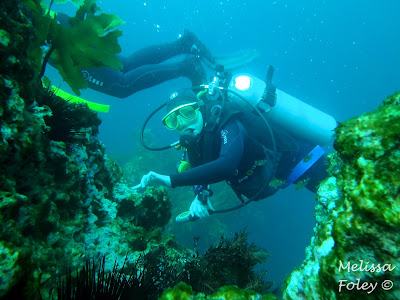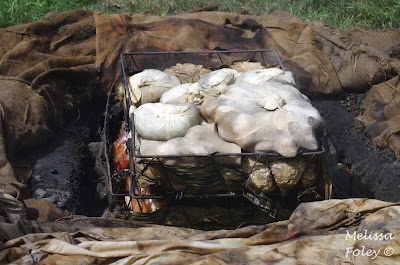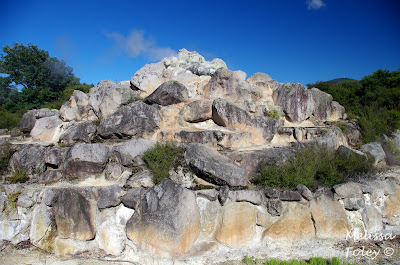A week after my mom and cousin flew out of NZ, our dear friends Jenny and Andrew arrived from Santa Cruz. They not only spoiled us by visiting, but they also brought us an assortment of California goodies we were missing. We are now officially off rationing the bbq sauce and tapatio!
Our second dive was on a pinnacle that we circumnavigated multiple times during the dive. The pinnacle had a lot of nooks and crannies so this dive featured the small critters on the rocks rather than the big, showy fish.
Jenny and Andrew have both been to NZ multiple times prior to this visit so we stuck relatively close to home and did a lot of hiking in Auckland's fabulous regional parks while they were here. Our first hike was south of Auckland in the Hunua Range. With the Waitakere Range closed for the foreseeable future, I think the Hunuas will become our go-to spot for local(ish), forested hikes. We provisioned for our lunch at the Clevedon Market, a hopping farmers/food/artisanal goods market south of Auckland. We hiked the steepest part of the trail first and rewarded ourselves with lunch overlooking the Wairoa reservoir, one of the four that supply drinking water to Auckland.
Wairoa reservoir
tree fungus
The following day, we managed to get a slightly soggy hike in at Te Henga beach and Lake Wainamu before ex-cyclone Hola arrived. Hola is the third ex-cyclone we've gotten hit by this summer--which is a rare occurrence. The storms have not hit NZ at cyclone strength, but they still pack a pretty good punch with wind and lots of rain. We had envisioned a sunny day and swimming at the lake, but oh well.
patterns on the black sand beach (Te Henga)
walking up the stream to Lake Wainamu
the massive black sand dunes at Lake Wainamu
Our big trip was north to Tutukaka, a tiny coastal village that is the jumping off point for the Poor Knights Islands. Pete and I dove there in December but wanted to go back for another trip. With the help of a coworker, we chartered a boat for the four of us and 10 of our coworkers. On our way north, we stopped at the Tawheranui Peninsula to try to find some birds contained in the predator-free area. We managed to see quite a few endemic and endangered birds, including a daytime sighting of the ruru (morepork), NZ's only owl species.
pukeko drying its feathers
the very squawky saddleback alerted me to the
potential for a nearby ruru (morepork)
potential for a nearby ruru (morepork)
This very inquisitive ruru flew to another branch shortly after this
photo, demonstrating its near silent flight. It was impressive!
photo, demonstrating its near silent flight. It was impressive!
Pateke (brown teal) foraging for lunch
We met our coworkers in Tutukaka Friday evening and set out for our dives early Saturday morning. We were the first dive boat out of the harbour that morning, so our boat captain took us through and around some of the arches in the islands before anchoring at our first dive site.
the geology of the islands is so cool!
sometimes it is good to be on the small boat...
Our first dive was at a site called northern arch where the fish and kelp were plentiful!
Pete entering the arch
some of the incredible encrusting life on the arch walls
Pete, Andrew, and Jenny swimming along
the edge of the kelp forest
the edge of the kelp forest
a moray eel saying "hello"
Our second dive was on a pinnacle that we circumnavigated multiple times during the dive. The pinnacle had a lot of nooks and crannies so this dive featured the small critters on the rocks rather than the big, showy fish.
a morose tambja nudibranch
a lovely vercoes tambja nudibranch
Jenny peaking through a rock crevice
The forecast had called for rain much of the day, but we were treated to sunshine until our second dive ended. At that point, the weather started to turn and the wind and swell picked up. Fortunately we weren't diving the next day because all trips were cancelled due to high winds and big seas. I think the "Jenny" effect was in full force during their trip...
On our way back to Auckland we stopped at Waipu caves where we were told we could see glow worms. And glow worms we found! We walked through the stream, passing by interesting limestone formations, stalactites, and mud-coated stalagmites. Once we were out of the light from the cave entrance, we started to see the faint bluish specks of light being emitted from the glow worms. The further into the cave we walked, the more glow worms we saw. There was one wall that was covered in them, making the cave wall look like a starry sky.
A glow worm on the cave roof. The sticky strands catch the food;
the body of the larvae is inside the tube running horizontal in about
the center of the photo. If you look closely, you can see a
blue dot on the tube - that is the light they emit.
the body of the larvae is inside the tube running horizontal in about
the center of the photo. If you look closely, you can see a
blue dot on the tube - that is the light they emit.
a narrow passage with limestone waves
a limestone shelf near the cave entrance
It was great to have our friends here, to show them our new city, and to feel like we had a piece of our California home here. Thanks for a wonderful visit!




























































